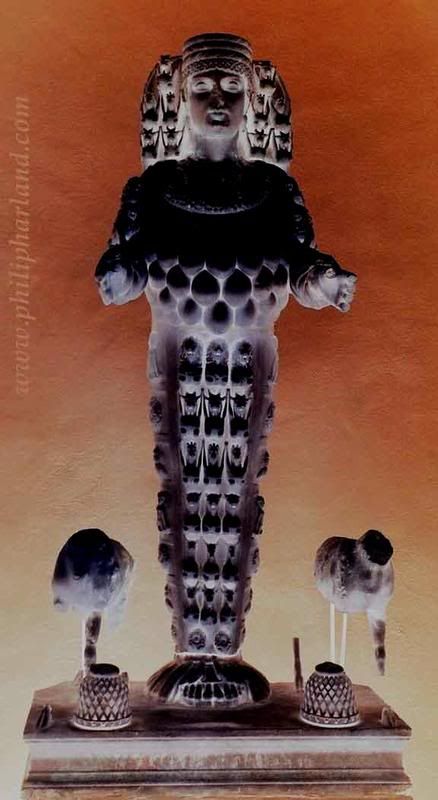
* The quest romance of male sex is a war between identity and annihilation. An erection is a hope for objectivity, for power to act as a free agent. But at the climax of his success, woman is pulling the male back to her bosom, drinking and quelling his energy...Woman and nature stand ever ready to reduce the male to boy and infant.
The operations of sex are convulsive, from intercourse through menstruation and childbirth: tension and distention, spasm, contraction, expulsion, relief. The body is wrenched in serpentine swelling and sloughing. Sex is not the pleasure principle but the Dionysian bondage of pleasure-pain. So much is a matter of overcoming resistance, in the body or the beloved, that rape will always be a danger. Male sex is a repetition-compulsion: whatever a man writes in the commentary of his phallic projections must be rewritten again and again. Sexual man is the magician sawing the lady in half, yet the serpent head and tail always live and rejoin. Projection is a male curse: forever to need something or someone to make oneself complete. This is one of the sources of art and the secret of its historical domination by males. The artist is the closest man has come to imitating woman's superb self-containment.
3- Artemis de Ephesus
The operations of sex are convulsive, from intercourse through menstruation and childbirth: tension and distention, spasm, contraction, expulsion, relief. The body is wrenched in serpentine swelling and sloughing. Sex is not the pleasure principle but the Dionysian bondage of pleasure-pain. So much is a matter of overcoming resistance, in the body or the beloved, that rape will always be a danger. Male sex is a repetition-compulsion: whatever a man writes in the commentary of his phallic projections must be rewritten again and again. Sexual man is the magician sawing the lady in half, yet the serpent head and tail always live and rejoin. Projection is a male curse: forever to need something or someone to make oneself complete. This is one of the sources of art and the secret of its historical domination by males. The artist is the closest man has come to imitating woman's superb self-containment.
3- Artemis de Ephesus

Everything is melting in nature. We think we see objects but out eyes are slow and partial. Nature is blooming and withering in long puffy respirations, rising and falling in oceanic wave-motion. A mind that opened itself fully to nature without sentimental preconception would be glutted by nature's coarse materialism, its relentless superfluity...See nature spuming and frothing, its mad spermatic bubbles endlessly spilling out and smashing in that inhuman round of waste, rot and carnage... This is the chthonian black magic with which we are infected as sexual beings; this is the daemonic identity that Christianity so inadequately defines as original sin and thinks it can cleanse of us . Procreative woman is the most troublesome obstacle to Christianity's claim to catholicity, testified by its wishful doctrines of Immaculate Conception and Virgin Birth. The procreativeness of chthonian nature is an obstacle to all of western metaphysics and to each man in his quest for identity against his mother. Nature is the seething excess of being.
The most effective weapon against the flux of nature is art.
...e que, pela gloriosa intercessão da bem-aventurada sempre Virgem..., sejamos livres da presente tristeza e gozemos da eterna alegria...
...Vos rogamos que envieis as Legiões Celestes para que às Vossas ordens persigam e combatam os demónios por toda a parte, refreando a sua audácia e precipitando-os no abismo...

* in "Sexual Personae", Camille Paglia

2- Mary 13 May
The Devi Mahatmya (Sanskrit: devīmāhātmyam, देवीमाहात्म्यम्, "Glory of the Goddess") is the first religious text to define the Supreme Reality (God) as a female principle. It is a synthesis of the then prevailing local Mother goddess cults of Aryan and non-Aryan origin. The three episodes of the text may be considered allegories of outer and inner experience. In it the Goddess is Shakti, power itself, beyond the patriarchal relegation of consorting with any eclipsing male deity or patriarchal construct. Here, for the first time, "the various mythic, cultic and theological elements relating to diverse female divinities were brought together in what has been called the 'crystallization of the Goddess tradition."
The entire text is considered one mantra.  Durga, also called Divine Mother, protects mankind from evil and misery by destroying evil forces such as selfishness, jealousy, prejudice, hatred, anger, and ego. The worship of Goddess Durga is very popular among Hindus. She is also called by many other names, such as Parvati, Bhavani, and Kali In the form of Parvati, She is known as the divine spouse of Lord Shiva and is the mother of Her two sons, Ganesha and Karttikeya.
Durga, also called Divine Mother, protects mankind from evil and misery by destroying evil forces such as selfishness, jealousy, prejudice, hatred, anger, and ego. The worship of Goddess Durga is very popular among Hindus. She is also called by many other names, such as Parvati, Bhavani, and Kali In the form of Parvati, She is known as the divine spouse of Lord Shiva and is the mother of Her two sons, Ganesha and Karttikeya. Vós que recebestes de Deus o poder e a missão de esmagar a cabeça de Satanás, humildemente Vos rogamos que envieis as Legiões Celestes para que às Vossas ordens persigam e combatam os demónios por toda a parte, refreando a sua audácia e precipitando-os no abismo. Ó Bondosa e Carinhosa Mãe, Vós sereis sempre o nosso amor e a nossa esperança.
Senhor Deus, nós Vos suplicamos que concedais aos vossos servos perpétua saúde de alma e de corpo; e que, pela gloriosa intercessão da bem-aventurada sempre Virgem Maria, sejamos livres da presente tristeza e gozemos da eterna alegria. Por Cristo Nosso Senhor.
Senhor Deus, nós Vos suplicamos que concedais aos vossos servos perpétua saúde de alma e de corpo; e que, pela gloriosa intercessão da bem-aventurada sempre Virgem Maria, sejamos livres da presente tristeza e gozemos da eterna alegria. Por Cristo Nosso Senhor.

As transcendent, she is the heavenly queen who descends from time to time to maintain harmony on earth. [...] In her role as cosmic queen, warrior goddess, and demon slayer, [...]

Lendo, no contexto do Devi-mahatmya acima e abaixo citado, o excerto de uma carta da irmã Lúcia a falar sobre António Salazar (imagem acima), aquilo que concluo é, mais uma vez, desconfiemos sempre da transcendência e das formas de harmonia na terra transcendentemente"ditadas". Não existe, fora do discurso e dos sonhos, tal coisa como a transcendente Virgem Santíssima que desce dos céus; existe a terra e as suas criaturas e a sua creatividade; imanência.
[...] As immanent in the world Durga is equated with the earth.
she is the world, she is all this.As the earth itself she conveys cosmic stability [...] She is the foundation of all creatures and that which nourishes all creatures [...] she provides the world with food from her own body.
http://sai_maa.tripod.com/Mata/jaimatadi-2.htm
A Virgem Shanti não existe fora do mundo dos mitos criado pelo discurso humano. E o "poder" apropria-se do discurso pela posse dos meios amplificadores da propaganda.
(aproveita-se esta ocasião para celebrar a visita de Diamanda Galàs a Lisboa no passado dia 1o de Maio, na aula Magna. Foto entre os santos pastorinhos)
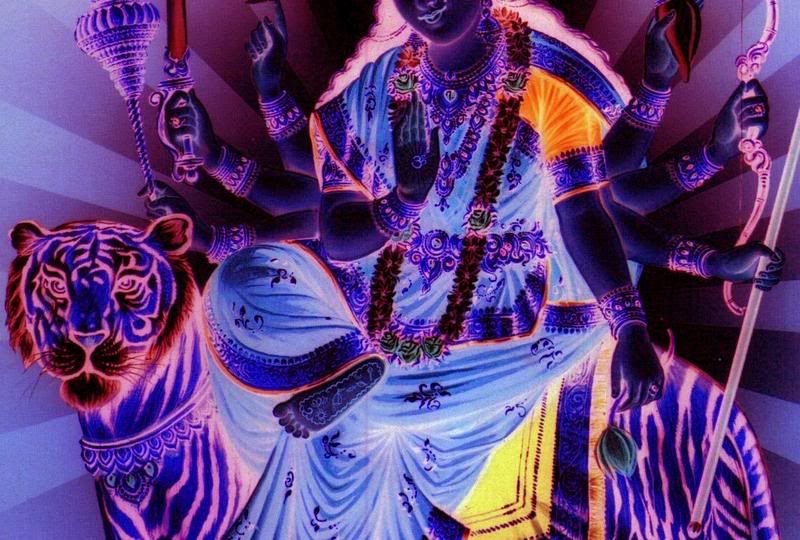
1- Durga Mata
The Devi-mahatmya makes a point at several places to say that she is the world, she is all this. As the earth itself she conveys cosmic stability. She is the foundation of all creatures and that which nourishes all creatures. As the embodiment of the earth she supports, protects, and mothers all beings. As Sakambhan she provides the world with food from her own body. In her role as cosmic queen, warrior goddess, and demon slayer, Durga in effect protects herself in her aspect as the-earth itself.
As immanent in the world Durga is equated with the earth.
As transcendent, she is the heavenly queen who descends from time to time to maintain harmony on earth.
As immanent in the world Durga is equated with the earth.
As transcendent, she is the heavenly queen who descends from time to time to maintain harmony on earth.
http://sai_maa.tripod.com/Mata/jaimatadi-2.htm
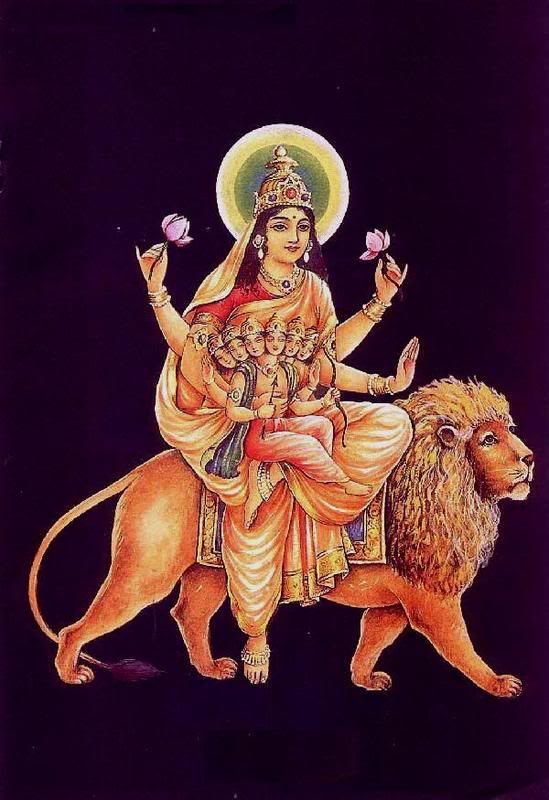
The Devi Mahatmya (Sanskrit: devīmāhātmyam, देवीमाहात्म्यम्, "Glory of the Goddess") is the first religious text to define the Supreme Reality (God) as a female principle. The text is a compilation and synthesis of far older myths and legends, skillfully integrated into a single narrative.
The entire text is considered one mantra.
Devi Mahatmya (DM) is based on the Samkhya philosophy.
It is a synthesis of the then prevailing local Mother goddess cults of Aryan and non-Aryan origin.
The three episodes of the text may be considered allegories of outer and inner experience.
The entire text is considered one mantra.
Devi Mahatmya (DM) is based on the Samkhya philosophy.
It is a synthesis of the then prevailing local Mother goddess cults of Aryan and non-Aryan origin.
The three episodes of the text may be considered allegories of outer and inner experience.

Written sometime around the sixth century AD in Sanskrit it tells of the Goddess's various mythological exploits. To this day it is used in the worship of the Goddess and is greatly revered by her devotees.
The Goddess's character, or "personality," however, is distinctive and centers around her most popular epithets Ambik and Candik
and Candik . The former name emphasizes her motherly qualities and the later emphasizes her fierce qualities.
. The former name emphasizes her motherly qualities and the later emphasizes her fierce qualities.
The Goddess as the fierce mother expresses a coincidence of opposites.
This aspect of her character, it is argued, expresses the ambiguities inherent in human existence itself.
The Goddess expresses both the Hindu emphasis upon the warm, nurturing nature of existence (the world of dharma and the abundance of prakrti) and the emphasis on the ephemeral, limited, painful aspects of the phenomenal world.
 and Candik
and Candik . The former name emphasizes her motherly qualities and the later emphasizes her fierce qualities.
. The former name emphasizes her motherly qualities and the later emphasizes her fierce qualities.The Goddess as the fierce mother expresses a coincidence of opposites.
This aspect of her character, it is argued, expresses the ambiguities inherent in human existence itself.
The Goddess expresses both the Hindu emphasis upon the warm, nurturing nature of existence (the world of dharma and the abundance of prakrti) and the emphasis on the ephemeral, limited, painful aspects of the phenomenal world.

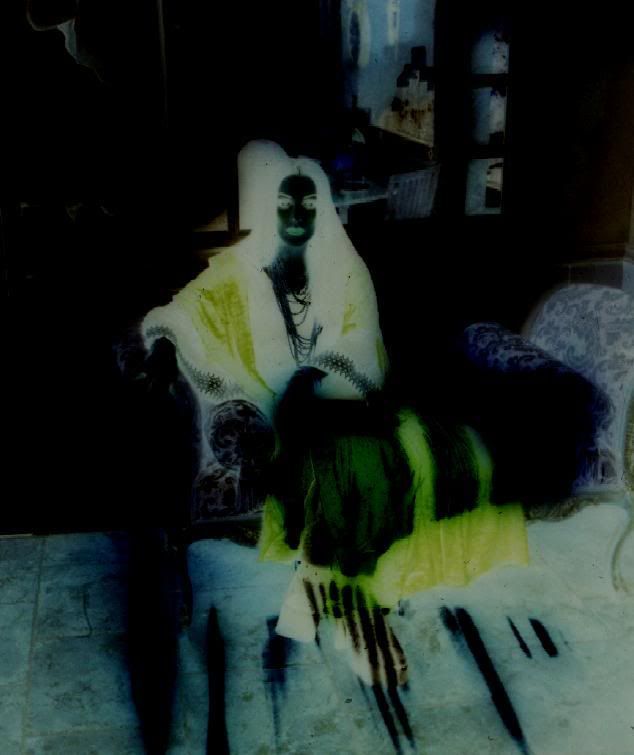
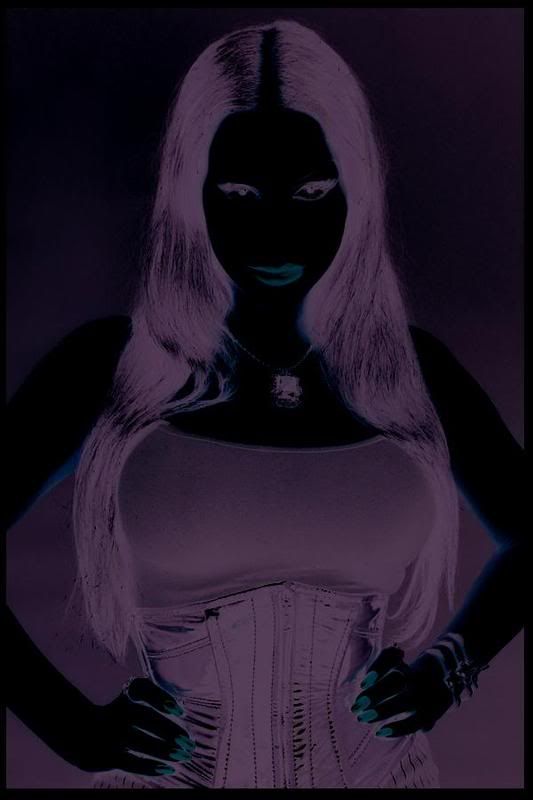
10 comments:
Zerinhos
Tu e a diversidade... e todos dentro deste Planeta azul...
por amor da deusa!, o teu blogue parece um portal do oculto...
Here we go again, playing the fool again.
Here we go again, acting hard again.
All right!
Well I'm beginning to see the light!
Zerinhos e Milagres?
Milagres há? posso fazer o pedido?
(não dá para comentar lá em cima)
[tenho de deixar a leitura para depois, mas não resisto a dizer que aquela imagem da aparição da Stª Angelina numa loja de conveniência americana está genial]
invejinha (da boa) por não ter ido a esse concerto...
;)*
ólha, ólha...os meus piquenos!
Não sei se percebi muito bem, mas parece-me que tu achas que aquilo que está na cabeça das pessoas, não sendo palpável, não é real.
Eu discordo, pode atinjir uma realidade avassaladora.
o que está dentro da cabeça das pessoas é a maior realidade de todas, é a sua única realidade
(acho eu, que às vezes também gosto de achar coisas)
mas isso é bem diferente do "misticismo provocado" e da "alienação do povo pela religião"
grande post 0.plus...
*
t(r)emendo a deus ... ~
VdeB e sonho:
achei (também gosto muito de achar:)
muita piada ao facto de aquilo que os pastorinhos viram no dia 13-05 foi uma deusa Hindu chamada Durga Mata.
Ou talvez tenha sido uma deusa mediterranea chamada Artemis ( a senhora que se segue)
Eu também acho que as coisas que estão na cabeça das pessoas, e na cabeça colectiva das culturas, são tão reais, embora não mais reais do que a realidade externa. Mas sim, tão reais quanto, e talvez bem mais determinantes no comportamento do que a realidade natural.
Mas também me interessou o facto de Durga Mata a deusa Hindu ter dois aspectos, o transcendente (quem supostamente vêm do céu) e o Imanente.
Enquanto aspecto Imanente ela é a Terra, a natureza, as creaturas.
Tentei sugerir que tomar as coisas divinas ou seja os mitos creados pelas cabeças humanas, como sendo transcendentes, ou seja existindo na realidade exterior como as árvores, os oceanos, etc, é mais uma faceta das tiranias, do exercício abusivo do poder.
Referências a Foucault, Grasmci, Deleuze, Kropotkin sobre o assunto do poder e da tirania.
E tentei perceber um pouco mais quem é afinal essa Deusa Maria de que tanto se fala, e que tem um mês no calendário romano só para ela.
Post a Comment